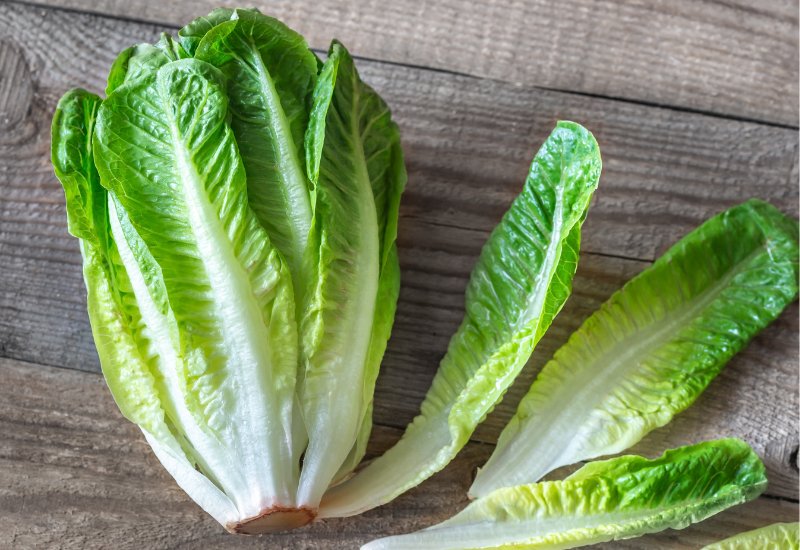How to revive wilted lettuce: Have you ever found yourself with a batch of wilted lettuce, unsure of whether to toss it or try to save it? Don't worry. A simple solution can help you revive your wilted greens and enjoy a fresh, crisp salad. It happens to everyone—sometimes, we forget about that lettuce in the fridge or it's exposed to too much heat, causing it to lose its crunch.
In this article, we'll walk you through a couple of easy tricks to bring your lettuce back to life. Following these steps can save you from wasting food and get the most out of your vegetables. So, get ready to reclaim your lettuce and elevate your salad game!
If you want to skip the article, just watch this video instead:
Reviving Kale is a very similar process as well. That's Why I added the video above.
How to Revive Wilted Lettuce
Reviving wilted lettuce is easier than you think. In this section, we'll explore two simple and effective techniques on how to revive it and bring back the crispiness.
Soaking in Cold Water
The first technique involves soaking your it in cold water. Start by filling a large bowl with cold tap water. Gently submerge the lettuce leaves in the water, making sure that they're completely covered. Allow the leaves to soak for about 30 minutes or until they no longer appear soft and wilted. This process helps to rehydrate the leaves by allowing moisture to be absorbed through osmosis, which restores their crisp freshness.
Using Ice Water Bath
For an even crisper lettuce revival, you can use ice water. Fill a large bowl or salad spinner with ice-cold water - the colder, the better.
Add a handful of ice cubes to a big bowl to further chill the water. Separate the leaves you want to bring back from the dead.
Carefully submerge the leaves in the water, ensuring that they're fully immersed. Let them soak for about 30 minutes or until fully crisp and rejuvenated.
The above ice bath or water bath helps to quickly hydrate the lettuce leaves through the process of osmosis while also rapidly cooling them.
The lower temperature is particularly beneficial for your hardy greens too, restoring the firm texture to your greens and leafy greens that can be lost with wilting.
Additional Steps to Enhance Freshness
You can further enhance its freshness and taste with a simple trick and few extra steps. These simple yet effective methods will help you get the most out of your leafy greens.
Trimming
It's also important to trim the stems of the lettuce. This will help the leaves hydrate better as you revive them. Use a sharp knife to neatly trim the ends of the stems before placing your greens in ice water.
Adding Vinegar or Lemon Juice
Once your lettuce is fully revived, you can add a splash of vinegar or lemon juice to give it an extra tang and help it keep more water stay fresh for longer. Cider vinegar or white vinegar will work well for this purpose.
Simply mix a few drops of vinegar or lemon juice into a bowl of water, then briefly dip your leaves into the mixture. This will impart a subtle tanginess that complements the fresh taste of the greens while also preserving their crispiness.
Following these additional steps ensures that your lettuce stays as fresh and delicious as possible. Enjoy your revitalized leafy greens and the various health benefits they provide.
Signs of Wilted Lettuce
One of the primary signs is the leaves' appearance. Instead of being crisp and firm, wilted lettuce leaves will appear soft, limp, and droopy. It has lost its water content, causing the leaves to lose their structure and turgidity.
Another common sign is the color. Healthy lettuce leaves will be vibrant and green, while wilted leaves may take on a dull or yellowish hue. This color change occurs as the lettuce begins to decay or suffer from dehydration.
When handling or touching the leaves, you may notice that it the leafy greens themselves will have a slimy texture. This sliminess can be attributed to the breakdown of cell walls, which releases internal moisture. Slimy lettuce leaves are unappetizing and a potential breeding ground for bacteria. Throw them away.
Besides visual and tactile cues, you should also pay attention to the lettuce's smell. Healthy lettuce should have a subtle, fresh, and earthy aroma. If it's gone bad, on the other hand, it will exhibit a stronger, unpleasant, or rotting odor.
Proper Storage for Long-Lasting Crispness
Storing your lettuce correctly can help maintain its crispness and freshness for longer. In this section, we'll discuss using the crisper drawer, creating humidity with a paper towel, and storing it with other produce for optimal storage conditions.
Using the Crisper Drawer
Your refrigerator's crisper drawer is designed to create an ideal environment for storing a variety of produce, including lettuce. To keep your lettuce fresh and crisp, place it in a plastic bag (you can reuse the one it came in from the store) and put it in the fridge or crisper drawer. The drawer's humidity control will help maintain the right moisture level.
Creating Humidity with a Paper Towel
Another method for keeping lettuce fresh is wrapping the leaves in an absorbent towel to maintain the right humidity levels. Place the damp towel wrapped leaves in a plastic bag for added protection, and this will help keep it hydrated and fresh for a longer time. Check the paper towel occasionally and replace it if it gets too damp.
Storing with Other Produce
When storing lettuce in the fridge, it's essential to consider the location and proximity to other produce items. It can be sensitive to ethylene gas released by some fruits like apples and bananas, which can cause it to wilt faster. Keep your lettuce away from these ethylene-producing fruits to maintain its crispness and freshness.
Reviving Other Vegetables and Greens
Rehydrating Herbs and Spinach
Recovering wilted herbs and spinach is a simple process. Fill a salad spinner or large bowl with cold water, and add some ice cubes for optimal results. Submerge your herbs and spinach in the water and let them sit for an hour or until they regain their freshness. Spin or pat dry before using.
Refreshing Carrots and Celery
Carrots and celery are known for their satisfying crunch, but they can become limp after a while. To refresh them, cut the ends of the stalks on a bias, which will expose more of the moisture-wicking capillaries. Fill a container with cold water and place the cut stalks in the water, standing upright. Store the container in the refrigerator for an hour to let them absorb the water and regain their firm texture.
I wrote an article on reviving celery here if you would like to read more on it.
Crisping Asparagus and Broccoli
If your asparagus or broccoli has become wilted, there's a straightforward way to crisp them up again. Fill a bowl or salad spinner with cold, icy water, and submerge the vegetables completely. Allow them to soak until their crispness has returned. If using immediately, placing the asparagus and broccoli in an ice-water bath is a good idea to ensure they maintain their freshly revived texture.
Wrote an article that goes more into detail about reviving broccoli here.
Incorporating Revived Lettuce into Meals
Now that you've successfully revived your lettuce, it's time to put it to good use in various meals.
Creating Crunchy Salads
Whether you're using iceberg lettuce, romaine, or arugula, the crisp texture will delight your taste buds.
When preparing a salad, remember to:
- Dry your lettuce thoroughly after reviving it – excess moisture can dilute the flavor of your salad dressing.
- Pair the crisp lettuce with other fresh ingredients like cherry tomatoes, cucumbers, and bell peppers for a colorful and nutritious meal.
- Experiment with different dressings to find your favorites and enhance the flavor of your salads. Don't be afraid to try homemade dressings using olive oil, vinegar, herbs, and spices.
Adding to Recipes
Beyond salads, incorporating revived lettuce into various recipes can elevate your dishes and add that satisfying crunch. Here are a few ideas to consider:
1. Sandwiches and wraps: Add it to your sandwiches and wraps as a healthy and crunchy layer. It will not only introduce your food to a burst of vitamins and nutrients but also add an interesting texture to your meal.
2. Stir-fries: Quickly sautéing lettuce, especially romaine or iceberg, can add a unique twist to your favorite stir-fry recipe. Ensure to cook it briefly so it retains its crunch and doesn't become overly wilted.
3. Tacos: Replace traditional taco shells with large lettuce leaves, or simply add a layer of crisp lettuce to your regular taco recipe for a refreshing crunch.
FAQ
How long should I soak wilted lettuce in cold water?
Soak your wilted lettuce in cold or ice water for about 15 to 30 minutes. This should be enough time for the leaves to regain their crispiness. The exact soaking time may vary depending on how wilted it is.
What temperature should the water be?
For best results, use very cold or ice water, ideally at around 120 degrees Fahrenheit. This will help rejuvenate the wilted lettuce more effectively than simply using tap water.
What if I don't have a salad spinner to air dry the lettuce after soaking?
No problem! You can dry your lettuce by rolling it in a clean paper or cloth towel. Just make sure to gently squeeze out and drain any excess water without crushing the leaves.
Can I add ice cubes to the water to make it colder?
Absolutely! Adding ice cubes to the water can help make it even colder and rehydrate the lettuce more effectively. Just be sure to remove the ice cubes before draining the lettuce to avoid any unwanted water splashes on other greens.
Can I use this method to revive other wilted vegetables?
Yes, this method works well for a variety of wilted vegetables. Simply adjust the soaking time depending on the thickness and type of vegetable. Keep in mind that delicate vegetables, even herbs and more tender herbs, might require a shorter soaking time than hardier ones.












